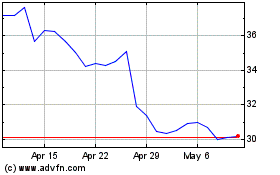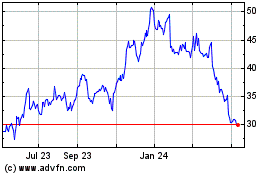Intel Reveals Details for Future High-Performance Computing System Building Blocks as Momentum Builds for Intel® Xeon Phi™...
November 17 2014 - 9:05AM
Business Wire
Discloses Future Generation Intel Xeon Phi
Processor and New Performance and Architectural Details for
Intel® Omni-Path Fabric Interconnect
Technology
SUPERCOMPUTING CONFERENCE (SC14)--Intel Corporation today
announced several new and enhanced technologies bolstering its
leadership in high-performance computing (HPC). These include
disclosure of the future generation Intel® Xeon Phi™ processor,
code-named Knights Hill, and new architectural and performance
details for Intel® Omni-Path Architecture, a new high-speed
interconnect technology optimized for HPC deployments.
Intel also announced new software releases and collaborative
efforts designed to make it easier for the HPC community to extract
the full performance potential from current and future Intel
industry-standard hardware.
Together, these new HPC building blocks and industry
collaborations will help to address the dual challenges of extreme
scalability and mainstream use of HPC while providing the
foundation for a cost-effective path to exascale computing.
News Facts
- Intel disclosed that its future,
third-generation Intel Xeon Phi product family, code-named Knights
Hill, will be built using Intel’s 10nm process technology and
integrate Intel Omni-Path Fabric technology. Knights Hill will
follow the upcoming Knights Landing product, with first commercial
systems based on Knights Landing expected to begin shipping next
year.
- Industry investment in Intel Xeon Phi
processors continues to grow with more than 50 providers expected
to offer systems built using the new processor version of Knights
Landing, with many more systems using the coprocessor PCIe card
version of the product. To date, committed customer deals using the
Knights Landing processor represent over 100 PFLOPS of system
compute.
- Recent high-profile Knights Landing
deals include the Trinity supercomputer, a joint effort between Los
Alamos and Sandia National Laboratories, and the Cori
supercomputer, announced by The U.S. Department of Energy’s (DOE)
National Energy Research Scientific Computing (NERSC) Center.
Additionally, DownUnder GeoSolutions a geosciences company,
recently announced the largest commercial deployment of
current-generation Intel Xeon Phi coprocessors, and the National
Supercomputing Center IT4Innovations announced a new supercomputer
that will become the largest Intel Xeon Phi coprocessor-based
cluster in Europe.
- Intel disclosed that the Intel
Omni-Path Architecture is expected to offer 100 Gbps line speed and
up to 56 percent lower switch fabric latency in medium-to-large
clusters than InfiniBand alternatives.1 The Intel Omni-Path
Architecture will use a 48 port switch chip to deliver greater port
density and system scaling compared to the current 36 port
InfiniBand alternatives. Providing up to 33 percent more nodes per
switch chip is expected to reduce the number of switches required,
simplifying system design and reducing infrastructure costs at
every scale. Expected system scaling benefits include:
- Up to 1.3x greater port density than
InfiniBand – enabling smaller clusters to maximize single switch
investments.2
- Use up to 50 percent fewer switches
than a comparable InfiniBand-based cluster of medium- to
large-size.3
- Up to 2.3x higher scaling in a two-tier
fabric configuration using the same number of switches as an
InfiniBand-based cluster – allowing for more cost-effective scaling
for very large cluster-based systems.4
- Intel launched the Intel Fabric
Builders Program to create an ecosystem working together to enable
solutions based on the Intel Omni-Path Architecture. An expansion
of the Intel Parallel Computing Centers was also announced,
bringing the total to more than 40 centers in 13 countries working
to modernize more than 70 of HPC’s most popular community
codes.
- Intel expanded its Lustre* software
capabilities with the release of Intel® Enterprise Edition for
Lustre software v2.2 and Intel® Foundation Edition for Lustre
software. New appliances using the enhanced Intel® Solutions for
Lustre software are currently being offered from Dell*, DataDirect
Networks* and Dot Hill*.
Continued TOP500 Momentum
Intel-based systems account for 86 percent of all supercomputers
and 97 percent of all new additions, according to the 44th edition
of the TOP500 list announced today. In the two years since the
introduction of the first-generation Intel Xeon Phi product family,
these many-core, coprocessor-based systems represent 17 percent of
the aggregated performance of all TOP500 supercomputers. The
complete TOP500 list is available at www.top500.org.
Supporting Quotes
- “Intel is excited about the strong
market momentum and customer investment in the development of HPC
systems based on current and future Intel Xeon Phi processors and
high-speed fabric technology,” said Charles Wuischpard, vice
president, Data Center Group, and general manager of Workstations
and HPC at Intel. “The integration of these fundamental HPC
building blocks, combined with an open standards-based programming
model, will maximize HPC system performance, broaden accessibility
and use, and serve as the on-ramp to exascale.”
- “The combination of Intel Xeon Phi
coprocessors with our proprietary software allows us to provide our
customers with one of the most powerful geo-processing production
systems to date,” said Dr. Matt Lamont, managing director,
DownUnder GeoSolutions. “Our Intel Xeon Phi powered solutions
enable interactive processing and imaging from each of our
geophysicists’ individual computers. A testing regime that once
took weeks can now be achieved in days. We’re thrilled with the
Intel Xeon Phi coprocessors and look forward to evaluating the
next-generation product.”
Supporting Resources
- Intel Xeon Phi product page:
www.intel.com/xeonphi
- Intel Omni-Path Architecture page:
www.intel.com/omnipath
- Intel Fabric Builders Program page:
http://fabricbuilders.intel.com
- Intel Parallel Computing Centers page:
https://software.intel.com/en-us/ipcc
- Intel Enterprise Edition for Lustre
software
v2.2:http://info.intel.com/HPDDSC14AnnouncementLandingPage.html
- Intel Foundation Edition for Lustre
software:http://info.intel.com/HPDDSC14AnnouncementLandingPage2.html
About Intel
Intel (NASDAQ: INTC) is a world leader in computing innovation.
The company designs and builds the essential technologies that
serve as the foundation for the world’s computing devices. As
a leader in corporate responsibility and sustainability, Intel also
manufactures the world’s first commercially available
“conflict-free” microprocessors. Additional information about Intel
is available at newsroom.intel.com and blogs.intel.com, and about
Intel’s conflict-free efforts at conflictfree.intel.com.
Intel, the Intel logo, Xeon and Intel Xeon Phi are trademarks of
Intel Corporation in the United States and other countries.*Other
names and brands may be claimed as the property of others.
1 Latency reductions based on Mellanox CS7500 Director Switch
and Mellanox SB7700/SB7790 Edge switches compared to preliminary
Intel simulations for Intel Omni-Path switches based on a 1024-node
full bisectional bandwidth (FBB) Fat-Tree configuration (2-tier, 5
total switch hops), using a 48-port switch for Intel Omni-Path
cluster and 36-port switch ASIC for either Mellanox or Intel® True
Scale clusters. Results have been estimated or simulated using
internal Intel analysis or architecture simulation or modeling, and
provided to you for informational purposes. Any differences in your
system hardware, software or configuration may affect your actual
performance.2As compared to a shipping 36-port edge InfiniBand
switch.3 Reduction in up to ½ fewer switches claim based on a
1024-node full bisectional bandwidth (FBB) Fat-Tree configuration,
using a 48-port switch for Intel Omni-Path cluster and 36-port
switch ASIC for either Mellanox or Intel® True Scale clusters.4
A2.3X based on 27,648 nodes based on a cluster configured with the
Intel Omni-Path Architecture using 48-port switch ASICs, as
compared with a 36-port switch chip that can support up to 11,664
nodes.
Intel CorporationBrian Garabedian,
408-765-0012brian.c.garabedian@intel.com
Intel (NASDAQ:INTC)
Historical Stock Chart
From Mar 2024 to Apr 2024

Intel (NASDAQ:INTC)
Historical Stock Chart
From Apr 2023 to Apr 2024
